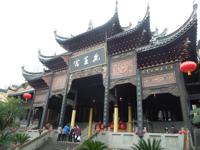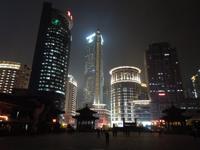Visitor Attractions in Chongqing
Interesting districts, temples and museums
Jiefangbei CBD is the vibrant business district of Chongqing, which is growing nestled into the heights between the Jialing and Yangtze Rivers. In the heart of this fast-developing commercial center, with many shops, offices, hotels and restaurants, is a pedestrian zone that opened in 1997 around the People's Liberation Monument. The monument, which was built in 1945 and was originally intended to commemorate victory over the Japanese, now symbolizes the Communist takeover of 1950.
 Ciqikou
was a well-known market and a trading center during the Ming Dynasty
(15th century), with its own harbor west of Chongqing. Today Ciqikou is located
in the midst of the Shapingba district of Chongqing, near the high-rise
buildings. Ciqikou will remain intact, though, because the government has
decided to preserve the old charm of the district, the better to attract
tourists. Several buildings have been restored, and many small souvenir shops
have now emerged, together with numerous food stalls and restaurants that serve
the local specialties.
Ciqikou
was a well-known market and a trading center during the Ming Dynasty
(15th century), with its own harbor west of Chongqing. Today Ciqikou is located
in the midst of the Shapingba district of Chongqing, near the high-rise
buildings. Ciqikou will remain intact, though, because the government has
decided to preserve the old charm of the district, the better to attract
tourists. Several buildings have been restored, and many small souvenir shops
have now emerged, together with numerous food stalls and restaurants that serve
the local specialties.
 The
Huguang Guild Hall -
a magnificent complex of houses, prayer houses and shops - was built by
immigrants from the southern provinces of Hubei, Guangdong, Guangxi and Hunan
during the Qing Dynasty. The Huguang Guild Hall was the center of life for these
people for more than 200 years.
The
Huguang Guild Hall -
a magnificent complex of houses, prayer houses and shops - was built by
immigrants from the southern provinces of Hubei, Guangdong, Guangxi and Hunan
during the Qing Dynasty. The Huguang Guild Hall was the center of life for these
people for more than 200 years.
 The Buddhist Luohan Temple was built 1000 years ago during the Song Dynasty, remodeled
in 1752, and rebuilt in 1945 after the Second World War. The name of this
popular place for worship and penance, “Luohan”, is the Chinese equivalent of
the Sanskrit word “arhat”, meaning a holy man who has left behind all earthly
desires and concerns and attained nirvana. The facility serves simultaneously as
a cloister for a small community of monks, and as the headquarters of the
Buddhist Society of Chongqing.
The Buddhist Luohan Temple was built 1000 years ago during the Song Dynasty, remodeled
in 1752, and rebuilt in 1945 after the Second World War. The name of this
popular place for worship and penance, “Luohan”, is the Chinese equivalent of
the Sanskrit word “arhat”, meaning a holy man who has left behind all earthly
desires and concerns and attained nirvana. The facility serves simultaneously as
a cloister for a small community of monks, and as the headquarters of the
Buddhist Society of Chongqing.
 The
cableway across the Yangtze River was put into operation in 1987 to increase
the efficiency of transport between the Yuzhong and Nan'an districts in
Chongqing without building expensive new bridges. With a span of 1,166 meters
(3800 feet), it is much longer than its sister cableway across the Jialing River
(1982-2011), but this latter is already no longer in operation. Huge bridges
will soon carry the CRT Line 6 over the Jialing River leading to Jiefangbai and
finally over the Yangtze River, so there is concern that the Yangtze Cableway
will be abandoned.
The
cableway across the Yangtze River was put into operation in 1987 to increase
the efficiency of transport between the Yuzhong and Nan'an districts in
Chongqing without building expensive new bridges. With a span of 1,166 meters
(3800 feet), it is much longer than its sister cableway across the Jialing River
(1982-2011), but this latter is already no longer in operation. Huge bridges
will soon carry the CRT Line 6 over the Jialing River leading to Jiefangbai and
finally over the Yangtze River, so there is concern that the Yangtze Cableway
will be abandoned.
 Hongyadong offers numerous shopping arcades and restaurants on multiple
levels, so you can spend hours strolling through shops and discover exquisite
dining. As a modern landmark of Chongqing, the building is impressive with its
rather garish appearance. Nevertheless, you should not miss the incredible
selection of souvenir shops, food stalls and really high-class restaurants.
Visiting a Hongyadong restaurant is a special treat, especially at night when
the bright lights come on and offer a beautiful view of the Jialing River.
Hongyadong offers numerous shopping arcades and restaurants on multiple
levels, so you can spend hours strolling through shops and discover exquisite
dining. As a modern landmark of Chongqing, the building is impressive with its
rather garish appearance. Nevertheless, you should not miss the incredible
selection of souvenir shops, food stalls and really high-class restaurants.
Visiting a Hongyadong restaurant is a special treat, especially at night when
the bright lights come on and offer a beautiful view of the Jialing River.
 The
Three Gorges Museum opened in 2005, and exhibits artifacts that were rescued
from land to be covered by the waters of the reservoir created behind the Three
Gorges Dam. The focus of the museum is on the culture and geography of the Three
Gorges region and construction of the dam, but displays also cover the history
and environment of Chongqing, from prehistoric times up to the Sino-Japanese War
of 1937-1945.
The
Three Gorges Museum opened in 2005, and exhibits artifacts that were rescued
from land to be covered by the waters of the reservoir created behind the Three
Gorges Dam. The focus of the museum is on the culture and geography of the Three
Gorges region and construction of the dam, but displays also cover the history
and environment of Chongqing, from prehistoric times up to the Sino-Japanese War
of 1937-1945.
 The Chongqing
Great Hall of the People was built between 1951-1954, and with its
huge dome that is modeled after the Temple of Heaven in Beijing, it is the best
known landmark in Chongqing. Musical and theatrical performances take place
under a dome 180 feet in height in an auditorium that seats 4000. At night, both
the Great Hall of the People and the People's Square in front of it are
spectacularly illuminated.
The Chongqing
Great Hall of the People was built between 1951-1954, and with its
huge dome that is modeled after the Temple of Heaven in Beijing, it is the best
known landmark in Chongqing. Musical and theatrical performances take place
under a dome 180 feet in height in an auditorium that seats 4000. At night, both
the Great Hall of the People and the People's Square in front of it are
spectacularly illuminated.
 Even a brief visit to the
Zoo in Chongqing is worthwhile because you can observe
many pandas at close quarters, while in Sichuan they are nearly extinct in the
wild. An early start is necessary if you wish to see the Panda feeding at 9 am.
However, this is also when most of the rest of the tourists will be present.
Even a brief visit to the
Zoo in Chongqing is worthwhile because you can observe
many pandas at close quarters, while in Sichuan they are nearly extinct in the
wild. An early start is necessary if you wish to see the Panda feeding at 9 am.
However, this is also when most of the rest of the tourists will be present.
 Eling Park is located on a hill in the middle of central Yuzhon District, and so
it offers a beautiful view of large parts of the city of Chongqing. The park was
established at the end of the Qing dynasty in 1909. It was built by a wealthy
businessman, and was renovated in 1958. Hundreds of plant species can be
discovered in different parts of the well-tended gardens, and there is a tea
house and a restaurant that cater to visitors. Tourists also enjoy the lookout
tower, which opened a few years ago and provides a suitable platform for
photographing the Chongqing skyline.
Eling Park is located on a hill in the middle of central Yuzhon District, and so
it offers a beautiful view of large parts of the city of Chongqing. The park was
established at the end of the Qing dynasty in 1909. It was built by a wealthy
businessman, and was renovated in 1958. Hundreds of plant species can be
discovered in different parts of the well-tended gardens, and there is a tea
house and a restaurant that cater to visitors. Tourists also enjoy the lookout
tower, which opened a few years ago and provides a suitable platform for
photographing the Chongqing skyline.
 The
Stilwell Museum recalls the cooperation between U.S. and China against
the Japanese in World War II. The exhibition is housed in the former
headquarters of the American officer, General Joseph W. Stilwell, who coordinated the entire theater of
war in China, Burma, and India (CBI) from Chongqing.
The
Stilwell Museum recalls the cooperation between U.S. and China against
the Japanese in World War II. The exhibition is housed in the former
headquarters of the American officer, General Joseph W. Stilwell, who coordinated the entire theater of
war in China, Burma, and India (CBI) from Chongqing.
 Chaotianmen lies at the confluence of the Jialing and Yangtze Rivers, at the tip
of Yuzhong peninsula. From here, the Yangtze River can be explored by boat, or
you can enjoy the view of the panorama with the Chaotianmen Bridge. Below the
plaza is also an exhibit with numerous models for urban development in Chongqing
(The Urban Planning Exhibition).
Chaotianmen lies at the confluence of the Jialing and Yangtze Rivers, at the tip
of Yuzhong peninsula. From here, the Yangtze River can be explored by boat, or
you can enjoy the view of the panorama with the Chaotianmen Bridge. Below the
plaza is also an exhibit with numerous models for urban development in Chongqing
(The Urban Planning Exhibition).

